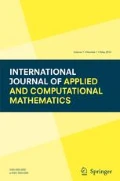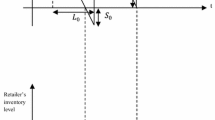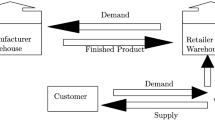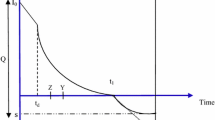Abstract
This paper determines the pricing, the replenishment cycle, and the number of shipments in a manufacturer–retailer supply chain of the deteriorating items. Generally speaking, deterioration items means products that their value is reduced over time. The relationship between the manufacturer and the retailer is analyzed by non-cooperative Stackelberg game, where the manufacturer is assumed to be the leader and retailer is the follower. It is assumed that inventory policy is non-delayed equal size shipments in which the manufacturer delivers shipments to the retailer in the production period. Also, the deterioration and demand rates are determined by probabilistic distribution function. First, an inventory control model for both the retailer and the manufacturer is formulated. Then, the conditions to obtain the optimal solution under non-cooperative Stackelberg equilibrium are derived. Next, a numerical example is extended by performing a sensitivity analysis and simulation of the model parameters and managerial insights are discussed. The main outcome of this paper is the optimal selling price and inventory control variables. Also, the results indicate that the conditions of inventory system determine the act of the manufacturer as a leader whether use its power against retailer as a follower or have a cooperation with the retailer. Moreover, the retailer’s total profit is more sensitive to the ordering costs than the other parameters and the decision variables of manufacturer significantly depend upon the manufacturer’s holding cost. In addition, the simulation results show the validation of the proposed model.



Similar content being viewed by others
References
Li, R., Lan, H., Mawhinney, J.R.: A review on deteriorating inventory study. J. Serv. Sci. Manag. 3(01), 117 (2010)
Chen, T.-H., Chang, H.-M.: Optimal ordering and pricing policies for deteriorating items in one-vendor multi-retailer supply chain. Int. J. Adv. Manuf. Technol. 49(1–4), 341–355 (2010)
Chen, J.-M., Chen, T.-H.: The profit-maximization model for a multi-item distribution channel. Transp. Res. Part E Logist. Transp. Rev. 43(4), 338–354 (2007)
Dolan, R.J., Simon, H.: Power Pricing: How Managing Price Transforms the Bottom Line. Free Press, New York (1996)
Marn, M.V., Rosiello, R.L.: Managing price, gaining profit. Harv. Bus. Rev. 70(5), 84–94 (1992)
Xiao, T., Xu, T.: Coordinating price and service level decisions for a supply chain with deteriorating item under vendor managed inventory. Int. J. Prod. Econ. 145(2), 743–752 (2013)
Yang, P.-C., Wee, H.-M.: Economic ordering policy of deteriorated item for vendor and buyer: an integrated approach. Prod. Plan. Control 11(5), 474–480 (2000)
Yang, P.-C., Wee, H.-M.: An integrated multi-lot-size production inventory model for deteriorating item. Comput. Oper. Res. 30(5), 671–682 (2003)
Rau, H., Wu, M.-Y., Wee, H.-M.: Integrated inventory model for deteriorating items under a multi-echelon supply chain environment. Int. J. Prod. Econ. 86(2), 155–168 (2003)
Rau, H., Wu, M.-Y., Wee, H.-M.: Deteriorating item inventory model with shortage due to supplier in an integrated supply chain. IJSyS 35(5), 293–303 (2004)
Zhou, Y.-W., Wang, S.-D.: Optimal production and shipment models for a single-vendor–single-buyer integrated system. Eur. J. Oper. Res. 180(1), 309–328 (2007)
Jonas, C., Wee, H., Wang, K.: Supply chain partnership for three-echelon deteriorating inventory model. Management 4(4), 827–842 (2008)
Yu, J.C.: Optimal deteriorating items inventory model with a three-echelon supply chain strategic alliance. Asia Pac. J. Oper. Res. 27(06), 693–711 (2010)
Wang, K.-J., Lin, Y.S., Yu, J.C.P.: Optimizing inventory policy for products with time-sensitive deteriorating rates in a multi-echelon supply chain. Int. J. Prod. Econ. 130(1), 66–76 (2011)
Glock, C.H.: The joint economic lot size problem: a review. Int. J. Prod. Econ. 135(2), 671–686 (2012)
Wang, K.-J., Lin, Y.-S.: Optimal inventory replenishment strategy for deteriorating items in a demand-declining market with the retailer’s price manipulation. AnOR 201(1), 475–494 (2012)
Maihami, R., Nakhai Kamalabadi, I.: Joint pricing and inventory control for non-instantaneous deteriorating items with partial backlogging and time and price dependent demand. Int. J. Prod. Econ. 136(1), 116–122 (2012)
Sarkar, B., Sarkar, S., Yun, W.Y.: Retailer’s optimal strategy for fixed lifetime products. Int. J. Mach. Learn. Cybern. 7(1), 121–133 (2016)
Sarkar, B., et al.: Flexible setup cost and deterioration of products in a supply chain model. Int. J. Appl. Comput. Math. 2(1), 25–40 (2016)
Sarkar, B.: An inventory model with reliability in an imperfect production process. Appl. Math. Comput. 218(9), 4881–4891 (2012)
Sarkar, B., Saren, S., Cárdenas-Barrón, L.E.: An inventory model with trade-credit policy and variable deterioration for fixed lifetime products. AnOR 229(1), 677–702 (2015)
Sarkar, B., Saren, S.: Partial trade-credit policy of retailer with exponentially deteriorating items. Int. J. Appl. Comput. Math. 1(3), 343–368 (2015)
Sarkar, B., Sana, S.S., Chaudhuri, K.: An inventory model with finite replenishment rate, trade credit policy and price-discount offer. J. Ind. Eng. (2013). doi:10.1155/2013/672504
Khanra, S., Mandal, B., Sarkar, B.: An inventory model with time dependent demand and shortages under trade credit policy. Econ. Model. 35, 349–355 (2013)
Sarkar, B.: An EOQ model with delay in payments and time varying deterioration rate. MComM 55(3), 367–377 (2012)
Sarkar, B.: An EOQ model with delay in payments and stock dependent demand in the presence of imperfect production. Appl. Math. Comput. 218(17), 8295–8308 (2012)
Maihami, R., Abadi, I.N.K.: Joint control of inventory and its pricing for non-instantaneously deteriorating items under permissible delay in payments and partial backlogging. MComM 55(5), 1722–1733 (2012)
Maihami, R., Karimi, B., Ghomi, S.M.T.F.: Effect of two-echelon trade credit on pricing-inventory policy of non-instantaneous deteriorating products with probabilistic demand and deterioration functions. Ann. Oper. Res. 1–37 (2016). doi:10.1007/s10479-016-2195-3
Maihami, R., Karimi, B.: Optimizing the pricing and replenishment policy for non-instantaneous deteriorating items with stochastic demand and promotional efforts. Comput. Oper. Res. 51, 302–312 (2014)
Sarkar, B.: A production-inventory model with probabilistic deterioration in two-echelon supply chain management. Appl. Math. Model. 37(5), 3138–3151 (2013)
Shah, Y.: An order-level lot-size inventory model for deteriorating items. AIIE Trans. 9(1), 108–112 (1977)
Sarkar, B., et al.: Mitigation of high-tech products with probabilistic deterioration and inflations. Am. J. Ind. Bus. Manag. 5(03), 73 (2015)
Hariga, M.: Optimal EOQ models for deteriorating items with time-varying demand. J. Oper. Res. Soc. 47, 1228–1246 (1996)
Petruzzi, N.C., Dada, M.: Pricing and the newsvendor problem: a review with extensions. Oper. Res. 47(2), 183–194 (1999)
Zhu, S.X.: Joint pricing and inventory replenishment decisions with returns and expediting. Eur. J. Oper. Res. 216(1), 105–112 (2012)
Wang, Y., Zhang, J., Tang, W.: Dynamic pricing for non-instantaneous deteriorating items. J. Intell. Manuf. 26, 629–640 (2013)
Cachon, G.P., Netessine, S.: Game theory in supply chain analysis. In: Simchi-Levi, D., Wu, S.D., Shen, Z.-J. (eds.) Handbook of Quantitative Supply Chain Analysis: Modeling in the E-Business Era, pp. 13–65. Springer, Boston, MA (2004)
Kohli, R., Park, H.: A cooperative game theory model of quantity discounts. Manag. Sci. 35(6), 693–707 (1989)
Abad, P.L.: Supplier pricing and lot sizing when demand is price sensitive. Eur. J. Oper. Res. 78(3), 334–354 (1994)
Abad, P.L., Jaggi, C.K.: A joint approach for setting unit price and the length of the credit period for a seller when end demand is price sensitive. Int. J. Prod. Econ. 83(2), 115–122 (2003)
Yang, P.C.: Pricing strategy for deteriorating items using quantity discount when demand is price sensitive. Eur. J. Oper. Res. 157(2), 389–397 (2004)
Esmaeili, M., Zeephongsekul, P.: Seller–buyer models of supply chain management with an asymmetric information structure. Int. J. Prod. Econ. 123(1), 146–154 (2010)
Zhang, J., et al.: Supply chain performance for deteriorating items with cooperative advertising. J. Syst. Sci. Syst. Eng. 1–27 (2015). doi:10.1007/s11518-015-5279-8
Chen, M.-S., et al.: Channel coordination and transaction cost: a game-theoretic analysis. Ind. Mark. Manag. 35(2), 178–190 (2006)
Huang, Z., Li, S.X.: Co-op advertising models in manufacturer–retailer supply chains: a game theory approach. Eur. J. Oper. Res. 135(3), 527–544 (2001)
Li, S.X., Huang, Z.: Managing buyer–seller system cooperation with quantity discount considerations. Comput. Oper. Res. 22(9), 947–958 (1995)
Li, S.X., Huang, Z., Ashley, A.: Seller–buyer system co-operation in a monopolistic market. J. Oper. Res. Soc. 46(12), 1456–1470 (1995)
Li, S.X., et al.: Cooperative advertising, game theory and manufacturer–retailer supply chains. Omega 30(5), 347–357 (2002)
Esmaeili, M., Aryanezhad, M.-B., Zeephongsekul, P.: A game theory approach in seller–buyer supply chain. Eur. J. Oper. Res. 195(2), 442–448 (2009)
Yue, J., et al.: Pricing and advertisement in a manufacturer–retailer supply chain. Eur. J. Oper. Res. 231(2), 492–502 (2013)
Jha, J.K., Shanker, K.: Single-vendor multi-buyer integrated production-inventory model with controllable lead time and service level constraints. Appl. Math. Model. 37(4), 1753–1767 (2013)
Lu, L.: A one-vendor multi-buyer integrated inventory model. Eur. J. Oper. Res. 81(2), 312–323 (1995)
Yue, J., et al.: Coordination of cooperative advertising in a two-level supply chain when manufacturer offers discount. Eur. J. Oper. Res. 168(1), 65–85 (2006)
Tiaojun, X., Xinxin, Y., Jiabao, Z.: Coordination of a supply chain with advertising investment and allowing the second ordering. Technol. Invest. 1(3), 191–200 (2010)
Basar, T., et al.: Dynamic Noncooperative Game Theory, vol. 200. SIAM, Philadelphia (1995)
Author information
Authors and Affiliations
Corresponding author
Rights and permissions
About this article
Cite this article
Maihami, R., Karimi, B. & Ghomi, S.M.T.F. Pricing and Inventory Control in a Supply Chain of Deteriorating Items: A Non-cooperative Strategy with Probabilistic Parameters. Int. J. Appl. Comput. Math 3, 2477–2499 (2017). https://doi.org/10.1007/s40819-016-0250-z
Published:
Issue Date:
DOI: https://doi.org/10.1007/s40819-016-0250-z




